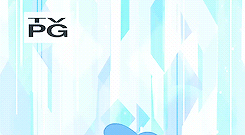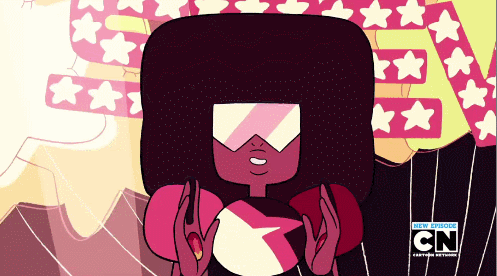In my last post I briefly mentioned Steven Universe, a Cartoon Network animated show. I want to give it a more in-depth review, though, because this is a show I’m currently absolutely smitten with, and I want to share the love!

As I mentioned in the last post, Steven Universe was created by a former Adventure Time writer: the whimsically named Rebecca Sugar. If I had to sum up the show’s themes in one word, it’d be love. Steven Universe is about love in all its forms. Every character is motivated in all they do by at least one kind of love, be it romantic love, parental love, love between friends, or even love for humanity and Earth.

The love isn’t restricted to the characters, though. It’s clear that a tremendous amount of love goes into the show from the people working on it. You can always tell when creators are pouring their hearts into what they’re making, and this show has that kind of love in spades. The visuals, art style and music are all evocative of a very specific mood the show is trying to create, and they’ve clearly been very carefully chosen to synergise perfectly. The writers clearly draw inspiration from old animes, video games, other cartoons, and various movies and TV shows, and they let it inform their work.
As for the premise, it’s an 11-minute-format animation about three magical warriors called the Crystal Gems, who are sworn to protect the Earth, and Steven, their half-human-half-gem family member, who must learn to be a Crystal Gem. The plot of most early episodes involve light-hearted hijinks based around Steven’s powers and his interactions with the other characters. (Is there also a supporting cast of quirky, loveable side characters? You bet there is.)

Later episodes, however, mostly connect more to a wider story arc, with recurring villains emerging, possibly with a connection to the Crystal Gem’s mysterious origins. More and more of the surprisingly deep lore, history and backstory of the Gems and the show’s universe (heh) are also revealed as time goes on.

Steven Universe is great whether it’s just chilling with side characters, exploring the lore of the world it’s set in, or advancing the main plot of the series. Every type of episode has different strengths, and the diversity makes the show always feel fresh. They can vary a fair amount in tone, whilst still maintaining a core aesthetic and feel for the series overall. Sometimes Steven (and the other Gems) mourn the loss of Steven’s Gem mother, sometimes Steven makes terrible (amazing) puns, sometimes the Gems are in mortal peril, and sometimes Steven’s fingers turn into cats. No matter what, though, the tone is always pitched in just the right way to sell the emotion they’re putting out there.
Of course, no review of the show would be complete without mentioning its staunch endorsement of various liberation movements. The feminist nature of the show should go without saying, and the commitment to racial diversity in its characters is commendable (both in the show and behind the scenes), but there’s more. Without wanting to spoil too much, I’ll just say LGBT representation is addressed. For children’s animation, this is still extremely novel, building and expanding on the ground The Legend of Korra broke in 2014. There’s also a less overt but still important discussion of gender identity, not just through the subversion of traditional gender roles in its characters, but also in a more direct way I don’t want to spoil!

I’ll end the review by summarising my favourite episode, The Test. In this episode, Steven learns a previous mission he went on with the Gems was less important than they’d made it seem; they’d used it as a test for him. Indignant, and thinking he’d failed, he insists they give him a new test so he can prove himself, so the Gems design a short custom “dungeon” for him to traverse, filled with traps (and a puzzle).
It’s hard not to notice the similarities between the dungeon and a video game level, specifically the kind of “dungeon” you’d expect in a Legend of Zelda game. Even the music takes on the kind of 8-bit aesthetic indicative of the older video games the writers clearly grew up with.
After much struggle, Steven gets to the last trap, which almost kills him. Then he realises the trap is rigged to never hit him. Frustrated, he goes back and checks the other traps, all of which refuse to harm him (even the puzzle was impossible to not solve). He then finds a way to access the roof of the dungeon (by “clipping” through it, like he’s in a buggy video game), and overhears the Gems talk about why they made the test un-failable. They express their exasperation at not knowing what they’re doing when raising him. They wanted to set the test to give him a confidence boost, because they saw him doubt himself.
After overhearing this, Steven runs through the dungeon again, reaches the exit, and confronts the Gems. Instead of getting mad at them, though, he plays along. He pretends he didn’t know the test was rigged, and thanks the Gems for setting up the test: “This was just what I needed.” But of course, it’s not what he needed, it’s what the Gems needed. They may be his guardians/surrogate mums, but they’re still fallible people, who sometimes need to be told they’re doing ok, too.

I can’t remember ever seeing that kind of reciprocal parent-child love in children’s television before. Imagine the kind of message that sends to kids: sometimes your parents need your encouragement as much as you need theirs. That’s just one small example of the countless positive and healthy life messages/morals Steven Universe gives to its viewers. If this is the kind of show today’s kids are growing up with, there’s hope for the future. That’s why the people of this world believe in Garnet, Amethyst, and Pearl (and Steven!)